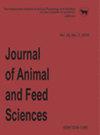In vitro gas production, rumen fermentation and production performance of steers fed multinutritional prickly pear blocks
IF 1.5
4区 农林科学
Q3 AGRICULTURE, DAIRY & ANIMAL SCIENCE
引用次数: 0
Abstract
. The aim of this study was to evaluate the replacement of oat hay exclusively with fermented prickly pear in developed multi-nutritional blocks (MNBs) on steer production efficiency and in vitro rumen fermentation parameters. Two experiments were performed: Trial 1 ( in vitro assay) evaluated in vitro fermentation parameters of three MNBs replacing oat hay (MNB0 – 0% prickly pear, MNB1 – 25% prickly pear, MNB2 – 25% fermented prickly pear). Trial 2 ( in vivo assay) evaluated the effect of MNBs on steer production performance. Both experiments were established as a completely randomized design. The values for proteins, metabolisable energy, gas production, methane and CO 2 were higher in MNB2 ( P < 0.05) group. Total and individual volatile fatty acids differed between experimental MNBs groups ( P < 0.05). Mean body weight and mean live-weight gain of steers were increased with MNB supplementation in T2 group by 12 and 37%, respectively. Dry matter digestibility was higher ( P < 0.05), but methane and CO 2 production in the rumen decreased with MNB supplementation ( P < 0.05). Replacing 25% of oat hay with fermented prickly pear leaves increases the nutritional quality of MNB2, while improving animal production variables and reducing rumen methane emissions.多营养刺梨块对肉牛体外产气量、瘤胃发酵及生产性能的影响
。本试验旨在评价以发酵刺梨代替纯燕麦干草对发育型多营养区(MNBs)阉牛生产效率和体外瘤胃发酵参数的影响。试验1(体外试验)评价3种MNBs (MNB0 - 0%刺梨、MNB1 - 25%刺梨、MNB2 - 25%发酵刺梨)替代燕麦干草的体外发酵参数。试验2(体内试验)评估了MNBs对阉牛生产性能的影响。两个实验均采用完全随机设计。MNB2组蛋白质、代谢能、产气量、甲烷和co2值均高于MNB2组(P < 0.05)。各试验组间总挥发性脂肪酸和单个挥发性脂肪酸含量差异显著(P < 0.05)。T2组添加MNB可使肉牛平均体重和平均活增重分别提高12%和37%。添加MNB提高了瘤胃干物质消化率(P < 0.05),降低了甲烷和co2产量(P < 0.05)。用发酵刺梨叶代替25%的燕麦干草,提高了MNB2的营养品质,同时改善了动物生产变量,减少了瘤胃甲烷排放。
本文章由计算机程序翻译,如有差异,请以英文原文为准。
求助全文
约1分钟内获得全文
求助全文
来源期刊

Journal of Animal and Feed Sciences
农林科学-奶制品与动物科学
CiteScore
2.10
自引率
0.00%
发文量
42
审稿时长
3 months
期刊介绍:
Journal of Animal and Feed Sciences (JAFS, J. Anim. Feed Sci.) has been published by the Kielanowski Institute of Animal Physiology and Nutrition, Polish Academy of Sciences in Jabłonna (Poland) since 1991. It is a continuation of the Polish-language journal Roczniki Nauk Rolniczych. Seria B, Zootechniczna published by the Polish Academy of Sciences since 1969.
JAFS is an international scientific journal published quarterly, about 40 papers per year including original papers, short communications and occasionally reviews. All papers are peer-reviewed and related to basic and applied researches in the field of animal breeding and genetics, physiology of nutrition, animal feeding, feed technology and food preservation. The journal distinguishes the multidisciplinary nature of physiological and nutritional sciences and so includes papers specialized in all fields connected with animal well-being, including molecular and cell biology and the emerging area of genetics.
 求助内容:
求助内容: 应助结果提醒方式:
应助结果提醒方式:


